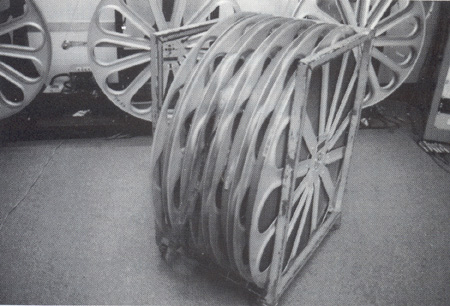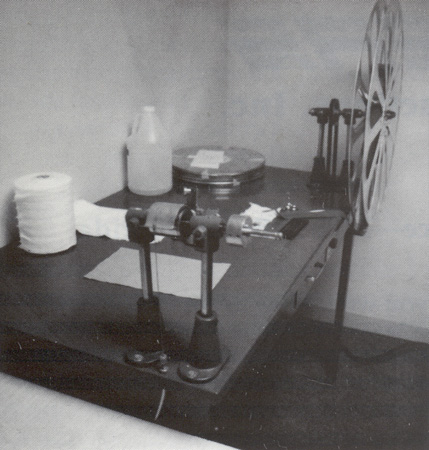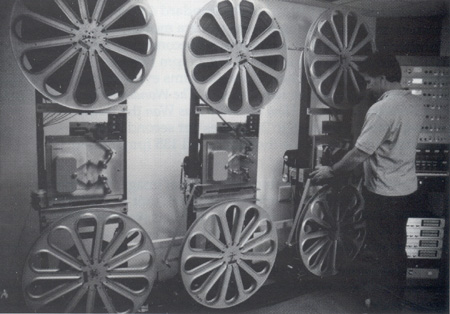|
| | So This Is Still Cinerama | Read more at
in70mm.com
The 70mm Newsletter
| | Written by: The Newsletter of Chace Productions, Inc. | Date: 04.04.2010 |
Cinerama, the format that earned it's designer,
Fred Waller, the nickname "The Man Who Blew Up The Movies", made a
return engagement to Chace Productions this fall [1998, editor]. Cinerama debuted in 1952 with
"This Is Cinerama". Now, many years later, four of the well known films required preservation transfers. With prior experience handling the Cinerama music score on "How The West Was Won", Pacific Theaters contacted Chace.
The Cinerama format featured a unique visual and aural experience for 1950's audiences. The screen was 75' long, 26' wide and spanned an arc of 146°. This wide screen experience encompassed the audience's peripheral vision. Three projectors, each projecting a separate left, center, or right panel were needed to fill the huge screen. In order to create a tall enough image, the 35mm Cinerama frame was 6 sprocket holes high instead of the standard 4 perfs. To reduce distracting strobing during camera movements, like pans, the film traveled at 26 frames per second. The result was a non-standard film speed of 146.25 fpm (feet per minute). In later years when Cinerama films evolved from novelty films to narrative features like, "The Wonderful World of The Brothers Grimm" or "How the West Was Won" the frame rate was reduced from 26 to 24 frames per second. The frame rate reduction made the film speed 135 fpm instead of 146,25 fpm.
| More in 70mm reading:
in70mm.com's Cinerama page
Chacers special Cinerama edition
Cinerama Films
Internet link:
chace.com
|  Everything is special for Cinerama including a film nick to hold the reels Everything is special for Cinerama including a film nick to hold the reels
To complement the all-encompassing visual image, the Cinerama sound system used a 35mm 7 track fullcoat mag that ran on a separate playback unit in sync with the projectors. According to Cinerama production notes, the original field recordings were recorded in 6 track stereo with six microphones. Considering recording technology of the 1950's, this was no simple task. After completion of post-production, the finished masters were recorded to a 7 track mag. This 7 track mag could be formatted as 6 track stereo with mono surround or as 7 or even 8 track stereo with stereo surrounds. In some films the surround format would change within the feature! The Cinerama crew member responsible for sound during the presentation would follow cue sheets indicating when patches and levels had to be changed.
In order to accurately transfer the seven track stereo mags, Chace called upon Gunther Jung of Cinerama. Gunther assisted Chace engineers in assembling the necessary inspection, playback, and recording equipment required for the job.
With a film speed of 146.25 fpm and no change overs, Cinerama films were shown in two parts of 45 minutes each. This meant that each reel was about 7500' long. The specially built, oversized reels, nicknarned "wagon wheels", weighed in at over 70 Ibs a piece. For this reason special dubbers capable of handling the reels were required.
Two mag players and one recorder, configured by the late Jack Dimmers of Teccon, were acquired by Pacific Theaters to accomplish the transfer. Another special piece of equipment that was needed was an oversized rewind bench. The bench with its heavy duty rewinds and spindles allowed for inspection and cleaning of the mag film prior to transfer. The first film to be transferred "The Search for Paradise" might have been more aptly narned, "the search for better elements".
Recorded on 30+ year old, 35mm fullcoat acetate mag the tracks were in various stages of deterioration. Shedding oxide, warping and shrinkage were the result of vinegar syndrome. Torn perfs, missing leaders and failed splices were caused by years of exhibition. Even though there were 18 reels to select from, not one complete set could be played without suffering damage. It is important to note that a set of Cinerama mags included both a 7 track stereo M&E
[Music & Effects, editor] and a 7 track stereo dialog/narration track. Cinerama adopted this format, split track masters, to provide for international distribution.
| The Newsletter of Chace Productions, Inc.
SPECIAL EDITION
Association of Moving Image Archivists Conference-Miami Beach, Florida, December 7-12, 1998
Welcome to another special A.M.I.A. Edition of CHACERS! If you would like to get Chacers on a regular basis, call Kristina Mathews at [800] 84AUDIO (842-8346). Or, you can get Chacers electronically by visiting our website at: www.chace.com
|  Heavy, duty rewinds and, spindles are required to inspect the 70 lbs. "Wagon Wheels". Heavy, duty rewinds and, spindles are required to inspect the 70 lbs. "Wagon Wheels".
In order to find a set of mags suitable for the transfer, "The Search for Paradise" led to Dayton, Ohio. The Neon Theatre in Dayton is the only remaining theatre to exhibit Cinerama in the United States. Fortunately, a complete English version, combined mag, was available for transfer. But even this "best of all mags" had been damaged. Midway through Part One there was a 2 1/2 foot slug.
It was no paradise searching through the other sets of elements to try to find the missing section. Hoisting wagon wheel after wagon wheel onto the dubbers was a workout. The search however proved fruitless. But brains are sometimes better than brawn, so a quick trip to a digital audio workstation provided an editorial solution.
With the section repaired, the final transfer was made to new 35mm, 5 mil polyester mags. In order to build the reels to the 8000' length, 2100' rolls of stock had to be assembled. A test transfer was made and auditioned in the Rick Chace Theatre. Despite the years of exhibition and copying without noise reduction, the track had surprisingly good quality. Obviously the faster transport speed contributed to an improved signal to noise ratio.
As the project progresses, the goal will be to preserve not only the mixed composite but also both the M&E and dialogue/Narration tracks.
| |  Thom Piper threads up the Cinerama dubber. Two machines are set up for playback and one for recording. Thom Piper threads up the Cinerama dubber. Two machines are set up for playback and one for recording.
Other shows likely to be copied are "Seven Wonders of the World", "South Seas Adventures" and "Windjammer". Though "The Search For Paradise" turned out to be the search for solutions the goal is to keep 7 track Cinerama off of the list of the Seven "Lost" Wonders of the World.
Thanks to Gunther Jung, John Harvey, Thom Piper, Joe Edwards, Robert Shames, Gilbert Paull, David Hunter and the late Jack Dimmers.
| | | | | | Go: back - top - back issues - news index
Updated
28-07-2024 | |
|
|